The Battle of Princeton was arguably the turning point of the Revolutionary War, the first time George Washington beat Cornwallis, thanks to Washington’s personal bravery that from that time forward inspired the continental troops.
But now preservation of the battlefield is threatened. Not by a strip mall. Not by a theme park. But by the Institute of Advanced Study, a graduate research institution (close to, but independent of Princeton University) which wants to build faculty housing on the site for its Institute of Advanced Study.
From George Will, A battle to save the Princeton battlefield – The Washington Post
In December 1776, the Revolution was failing. Britain had sent to America 36,000 troops — at that point, the largest European expeditionary force ever — to crush the rebellion before a French intervention on America’s behalf. Washington had been driven from Brooklyn Heights, then from Manhattan, then out of New York. The nation barely existed as he retreated across New Jersey, into Pennsylvania.
But from there, on Christmas night, he crossed the Delaware River ice floes for a successful 45-minute (at most) attack on Britain’s Hessian mercenaries at Trenton. This was Washington’s first victory; he had not been at Lexington, Concord or Bunker Hill. Trenton would, however, have been merely an evanescent triumph, were it not for what happened 10 days later.
On Jan. 2, 1777, British Gen. Charles Cornwallis began marching 5,500 troops from Princeton to attack Washington’s slightly outnumbered forces at Trenton. Washington, leaving a few hundred soldiers to tend fires that tricked Cornwallis into thinking the patriot army was encamped, made a stealthy 14-mile night march to attack three British regiments remaining at Princeton. They collided on this field.
The most lethal weapons in this war were bayonets. The British had them. Few Americans did, and they beat a panicked retreated from the advancing steel. By his personal bravery, Washington reversed this and led a charge. An unusually tall man sitting on a large white horse, he was a clear target riding as close to British lines as first base is to home plate. Biographer Ron Chernow writes that, at Princeton, Washington was a “warrior in the antique sense. The eighteenth-century battlefield was a compact space, its cramped contours defined by the short range of muskets and bayonet charges, giving generals a chance to inspire by their immediate presence.”
When the redcoats ran, the British aura of invincibility and the strategy of “securing territory and handing out pardons” (Chernow) were shattered. And the drift of American opinion toward defeatism halted.
[Keep reading. . .]
Mr. Will goes on to detail the plans to build faculty housing on this site. A historical conservation group offered the university $4.5 million for the property, a million over its appraised value, but the offer was spurned. A study commissioned by the Institute was conducted by postmodernist historians who sneered at the impulse to “fetishize space.”
But people are rallying in an effort to stop the university’s historical vandalism.















